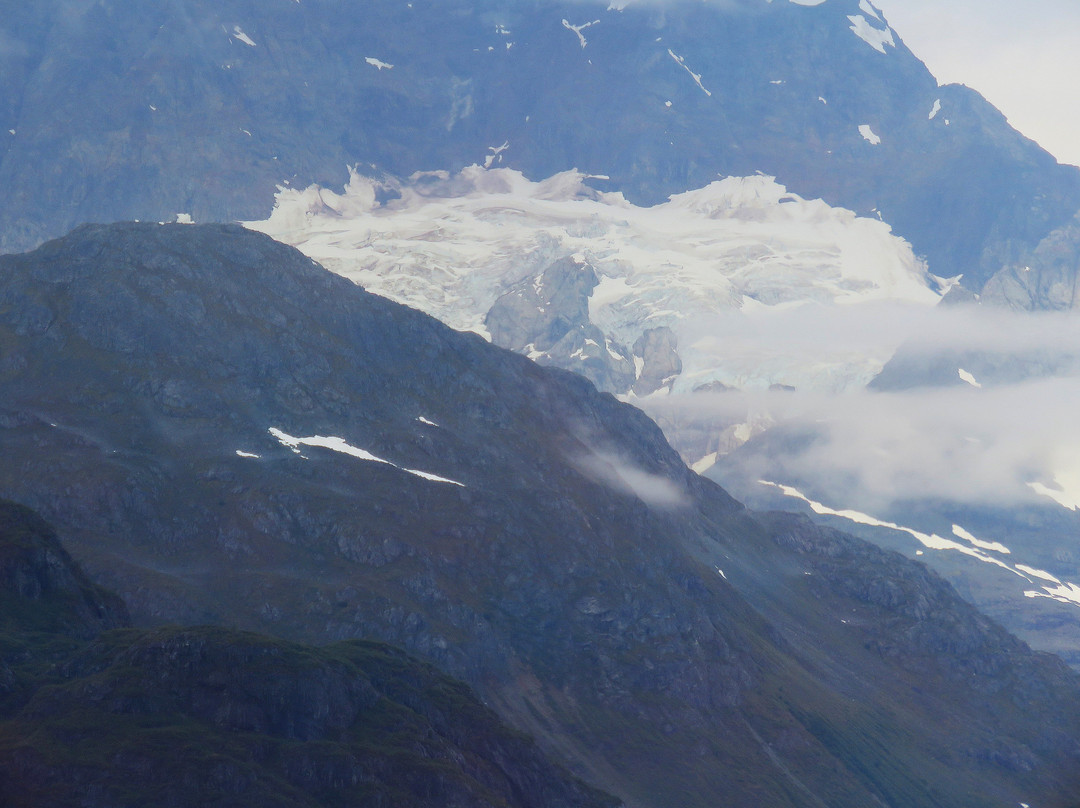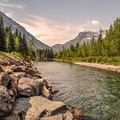的点评
A Beautiful, Sunny and Clear day.
冰川湾的点评
点评:President Calvin Coolidge declared ‘Glacial Bay’ to be a National Monument in February 1925. His intent was that all that natural beauty should be preserved for future generations. Today’s Glacier Bay is roughly the size of Connecticut with 1,375 sq. mls. of alpine glaciers, which account for more than ¼ of the park area, with most glaciers originating in mountains with elevation ranges of 8,000–15,000 ft.
250 years ago, Glacier Bay was a massive river of ice, estimated to be 100 miles long and thousands of feet deep. 1850 saw 150 glaciers. By 2022, that number decreased to 25 active glaciers. Today, our cruise ship took us 65 miles up the bay to reach our first visible tidewater glacier. Current predictions say that by 2030 the glaciers we are seeing now will no longer be visible.
#104c Against the ship’s side entering Glacier Bay.
#105c Close-up of a Glacial Cirque, where glaciers are formed.
#106 Green coastline S. of Russell Island
#107 Reid Glacier is 11-miles-long, ¾ mile wide and 150 ft. high. Its
partly terrestrial and partly tidewater.
# 108, b, c, Lamplugh Glacier is 8—miles long, 0.9 miles wide, 165 feet
high at the face, and over 19 miles long. Its flow rate is
approximately 0.75 —1 foot per day. It’s noted for the intense
blue color of its ice.
#109 Grand Pacific Glacier. This glacier is credited with carving
Glacier Bay. In the past 250 years it has receded to the head
of Tarr Inlet, where the terminus is no longer tidewater. What
we see now is the moraine cap stone. Its 16-miles-long.
#110, b, Margerie Glacier is found at the furthest north end of Tarr
Inlet. Margerie is a ‘cleaner’ glacier because it churns up the
embedded rock in to fine pieces; tidewater, because it flows
directly into the sea. It’s 21 miles long and moves relatively
quickly.
#111 Captain opened the Forward Deck for viewing.
#112 Johns Hopkins Glacier is found at the end of the Inlet of the
same name. It was the show piece of this trip, on a rare and
beautifully clear and sunny day. It’s 1 mile wide, and stands
250 feet above the water line. It also extends well into the sea
bed, protecting its underwater sea ice with a wall of
underwater moraine. It also has
‘stripes’; lateral moraine ice runs the length of the glacier.
Mounts Orville and Wilbur named for the Wright brothers, are
behind it. It is an advancing tidewater Glacier.
#112c is a similar photo, only with another large cruise ship on the
left. I appreciated the size comparison.
114, 114b Gloomy Knob is a mostly barren rock, composed of
dolomite which formed underwater in tropical regions.
Tectonic movement brought it to its present location.
115 115b Shoreline along Russel Island and b, with a glacial melt
stream.
116 Contrasting Colored rocks; beautiful against the green
water.
117 Sunset at Sea
250 years ago, Glacier Bay was a massive river of ice, estimated to be 100 miles long and thousands of feet deep. 1850 saw 150 glaciers. By 2022, that number decreased to 25 active glaciers. Today, our cruise ship took us 65 miles up the bay to reach our first visible tidewater glacier. Current predictions say that by 2030 the glaciers we are seeing now will no longer be visible.
#104c Against the ship’s side entering Glacier Bay.
#105c Close-up of a Glacial Cirque, where glaciers are formed.
#106 Green coastline S. of Russell Island
#107 Reid Glacier is 11-miles-long, ¾ mile wide and 150 ft. high. Its
partly terrestrial and partly tidewater.
# 108, b, c, Lamplugh Glacier is 8—miles long, 0.9 miles wide, 165 feet
high at the face, and over 19 miles long. Its flow rate is
approximately 0.75 —1 foot per day. It’s noted for the intense
blue color of its ice.
#109 Grand Pacific Glacier. This glacier is credited with carving
Glacier Bay. In the past 250 years it has receded to the head
of Tarr Inlet, where the terminus is no longer tidewater. What
we see now is the moraine cap stone. Its 16-miles-long.
#110, b, Margerie Glacier is found at the furthest north end of Tarr
Inlet. Margerie is a ‘cleaner’ glacier because it churns up the
embedded rock in to fine pieces; tidewater, because it flows
directly into the sea. It’s 21 miles long and moves relatively
quickly.
#111 Captain opened the Forward Deck for viewing.
#112 Johns Hopkins Glacier is found at the end of the Inlet of the
same name. It was the show piece of this trip, on a rare and
beautifully clear and sunny day. It’s 1 mile wide, and stands
250 feet above the water line. It also extends well into the sea
bed, protecting its underwater sea ice with a wall of
underwater moraine. It also has
‘stripes’; lateral moraine ice runs the length of the glacier.
Mounts Orville and Wilbur named for the Wright brothers, are
behind it. It is an advancing tidewater Glacier.
#112c is a similar photo, only with another large cruise ship on the
left. I appreciated the size comparison.
114, 114b Gloomy Knob is a mostly barren rock, composed of
dolomite which formed underwater in tropical regions.
Tectonic movement brought it to its present location.
115 115b Shoreline along Russel Island and b, with a glacial melt
stream.
116 Contrasting Colored rocks; beautiful against the green
water.
117 Sunset at Sea
翻译:1925 年 2 月,卡尔文·柯立芝总统宣布“冰川湾”为国家纪念碑。他的意图是,所有自然美景都应该为子孙后代保留下来。如今的冰川湾面积与康涅狄格州相当,拥有 1,375 平方英里的高山冰川,占公园面积的四分之一以上,大多数冰川起源于海拔 8,000-15,000 英尺的山脉。
250 年前,冰川湾是一条巨大的冰河,估计长 100 英里,深数千英尺。1850 年有 150 座冰川。到 2022 年,这个数字下降到 25 座活跃冰川。今天,我们的游轮载着我们沿着海湾向上游 65 英里,到达了我们第一个可见的潮水冰川。目前的预测表明,到 2030 年,我们现在看到的冰川将不再可见。
#104c 靠在船的侧面进入冰川湾。
#105c 冰川形成的地方,冰川的冰斗特写。
#106 拉塞尔岛南部的绿色海岸线
#107 里德冰川长 11 英里,宽 ¾ 英里,高 150 英尺。它的一部分是陆地,一部分是潮水。
#108,b,c,兰普卢冰川长 8 英里,宽 0.9 英里,表面高 165 英尺,长度超过 19 英里。它的流速约为每天 0.75-1 英尺。它以冰的深蓝色而闻名。
#109 大太平洋冰川。这座冰川被认为雕刻了冰川湾。在过去的 250 年里,它已经退缩到塔尔湾的源头,那里的终点不再是潮水。我们现在看到的是冰碛盖石。它有 16 英里长。
#110,b,玛格丽冰川位于塔尔湾最北端。玛格丽是一座“更干净”的冰川,因为它将嵌入的岩石搅成细小的碎片;潮水,因为它直接流入大海。它长 21 英里,移动速度相对较快。
#111 船长打开前甲板供参观。
#112 约翰霍普金斯冰川位于同名海湾的尽头。这是这次旅行的亮点,在一个罕见而晴朗的阳光明媚的日子。它有 1 英里宽,高出水面 250 英尺。它还延伸到海床深处,用一堵水下冰碛墙保护着它的水下海冰。它还有“条纹”;侧冰碛沿着冰川的长度延伸。以莱特兄弟命名的奥维尔山和威尔伯山就在它后面。这是一个前进的潮水冰川。#112c 是一张类似的照片,只是左边还有另一艘大型游轮。我很欣赏这种大小比较。114,114b Gloomy Knob 是一块大部分是贫瘠的岩石,由热带地区水下形成的白云石组成。构造运动把它带到了现在的位置。115 115b 拉塞尔岛沿岸的海岸线和 b,有一条冰川融水流。116 对比色的岩石;在绿水的映衬下美丽极了。117 海上日落
250 年前,冰川湾是一条巨大的冰河,估计长 100 英里,深数千英尺。1850 年有 150 座冰川。到 2022 年,这个数字下降到 25 座活跃冰川。今天,我们的游轮载着我们沿着海湾向上游 65 英里,到达了我们第一个可见的潮水冰川。目前的预测表明,到 2030 年,我们现在看到的冰川将不再可见。
#104c 靠在船的侧面进入冰川湾。
#105c 冰川形成的地方,冰川的冰斗特写。
#106 拉塞尔岛南部的绿色海岸线
#107 里德冰川长 11 英里,宽 ¾ 英里,高 150 英尺。它的一部分是陆地,一部分是潮水。
#108,b,c,兰普卢冰川长 8 英里,宽 0.9 英里,表面高 165 英尺,长度超过 19 英里。它的流速约为每天 0.75-1 英尺。它以冰的深蓝色而闻名。
#109 大太平洋冰川。这座冰川被认为雕刻了冰川湾。在过去的 250 年里,它已经退缩到塔尔湾的源头,那里的终点不再是潮水。我们现在看到的是冰碛盖石。它有 16 英里长。
#110,b,玛格丽冰川位于塔尔湾最北端。玛格丽是一座“更干净”的冰川,因为它将嵌入的岩石搅成细小的碎片;潮水,因为它直接流入大海。它长 21 英里,移动速度相对较快。
#111 船长打开前甲板供参观。
#112 约翰霍普金斯冰川位于同名海湾的尽头。这是这次旅行的亮点,在一个罕见而晴朗的阳光明媚的日子。它有 1 英里宽,高出水面 250 英尺。它还延伸到海床深处,用一堵水下冰碛墙保护着它的水下海冰。它还有“条纹”;侧冰碛沿着冰川的长度延伸。以莱特兄弟命名的奥维尔山和威尔伯山就在它后面。这是一个前进的潮水冰川。#112c 是一张类似的照片,只是左边还有另一艘大型游轮。我很欣赏这种大小比较。114,114b Gloomy Knob 是一块大部分是贫瘠的岩石,由热带地区水下形成的白云石组成。构造运动把它带到了现在的位置。115 115b 拉塞尔岛沿岸的海岸线和 b,有一条冰川融水流。116 对比色的岩石;在绿水的映衬下美丽极了。117 海上日落





















此点评仅代表旅行者个人的主观意见,并不代表TripAdvisor以及其合作方的意见。
关于我们
|新闻动态
|商务合作
|会员中心
|业主中心
|常见问题
|意见反馈
|联系我们
|营业执照
© 2025 Tripadvisor 版权所有。
使用条款 |隐私政策 |网站工作原理
部分照片由 VFM Leonardo 提供。
* Tripadvisor不是旅行社,也不是旅游预订服务代理商。我们提供免费、客观、公正的旅游资讯服务。 (显示更多)
TripAdvisor LLC 既不是预订代理商,也不是旅游运营商,不会向网站用户收取任何服务费。 按照规定,在 Tripadvisor 发布机票价格、游览和旅行套餐的合作伙伴(航空公司、旅行提供商及预订代理商),其标价须包含所有费用和附加费用。 例如, 机场出入境税费、消费税与其他服务费、手续费、杂费及附加费用。 当您向我们的某个合作伙伴进行预订时,请务必查阅他们的网站以了解当地行政部门要求的所有适用费用的具体情况。 除非另有说明,机票价格通常指的是一个人的价格(以人民币计)。
为方便起见,TripAdvisor LLC 根据从我们的预订合作伙伴获取的空房率计算每个酒店的均价。 对于游览和景点来说,所显示价格通常是每位成人的最低可用价格。 对于列出的任何旅行套餐或优惠,TripAdvisor LLC 无法保证任何特定的费率或价格。 此外,酒店均价每晚会更新,并以您的首选币种表示(使用现行汇率)。 由于这些已换算的价格是预估价格,因此,有关具体金额和币种请与预订网站进行核实。
此外,TripAdvisor LLC 无法保证我们网站上宣传的价格随时有效。 标价可能需要预订一定天数才能生效,或有不可用日期、使用条件或限制。
TripAdvisor公司对外部网站的内容一概不负责。优惠价格中不含税和其他费用。
ICP证:沪B2-20200433
沪ICP备20013175号
 沪公网安备31010502005427号
沪公网安备31010502005427号鹰程信息技术(上海)有限公司
货币/国家及地区
¥CNY
中国

